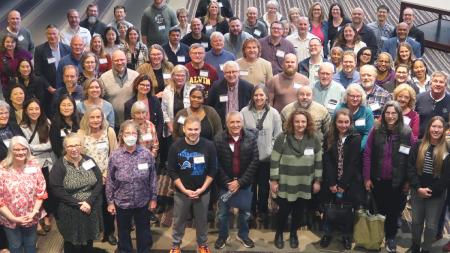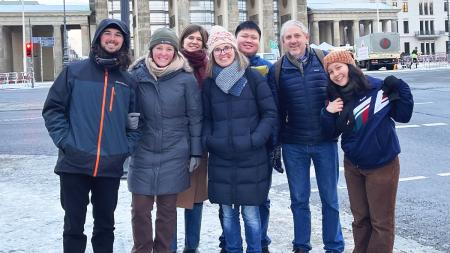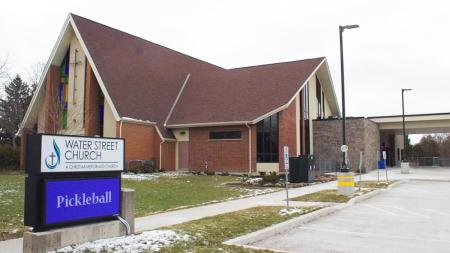Finding God in Surprising Places

Karen Wilk (fourth from the left) leads discussion about the prayer walk.
Chris Meehan
Karen Wilk led us on a mile-long prayer walk from the graffiti-decorated warehouses near Ttokamsa Home Mission Church to the spectacular Union Station in downtown Los Angeles.
In between were empty, fenced-in fields, a historic marker commemorating kiln-fired bricks used in the 1800s to pave streets in L.A., and Homeboy Industries, where ex-gang members receive job training.
“Pay attention as you walk,” Wilk, a missional leadership developer with Christian Reformed Home Missions, had told us before we left the church where the Christian Reformed Church Prayer Summit 2017 was in full swing.
“Try to listen to what God is saying. He is way ahead of us, doing incredible things. . . . Be available and tuned in,” said Wilk, who has seen God at work in Edmonton, Alta., where she helps run Neighborhood Life, a ministry of small neighborhood churches.
I was attending my fourth prayer summit. In fact, I’ve been at each one sponsored by the CRC, starting in 2012. Until this year, the denominational prayer summits have taken place on the large campus of All Nations CRC, 30 or so miles outside L.A. Memories from each event stick in my mind.
This year’s highlights include a talk by a Middle Eastern missionary who spoke of Muslims hungering to know more about Jesus, a sermon on unity by Reggie Smith, director of the offices of Race Relations and Social Justice, and a presentation by Makoto Fujimura, an artist and author of the new book Silence and Beauty: Hidden Faith Born of Suffering.
In the book, Fujimura touches on art, on Japanese culture and history, and on suffering, while at the same time he reflects on Shusaku Endo's masterpiece novel Silence, which recounts challenges and persecution faced by 17th-century Jesuit missionaries in Japan.
During his presentation, which took place just after the prayer walk, Fujimura spoke about the nature of prayer, wondering if we try too hard to connect with God.
“Quite possibly God, in his grace, power, and omniscience, simply asks us to sit and relax and be with Jesus. Perhaps that is all he wants us to do to pray effectively.”
By sitting still in the silence, we open ourselves to God, who can speak to us and penetrate our hearts and, when this happens, we become ready to do whatever work he has called us to do, said Fujimura.
“We go on a journey of silence and song. We realize we can just chill out and be with Jesus,” said the artist and writer.
Chilling out has always been hard for me. I like the idea of sitting back and letting God’s Spirit wash over me. But, in practice, I’m better at talking than listening, at doing than taking it easy, at walking the downtown streets of L.A. but not really hearing if God was trying to get through to me.
As Wilk took us on the prayer walk, I couldn’t hear God talking through the din of traffic, the whine of sirens, or the active meandering in my brain.
Still, I tried to pay attention to the people passing on the streets, to the guy in long dreadlocks who followed us for a few blocks, to the pagoda-shaped roof of the municipal rail stop welcoming people to Chinatown.
But I didn’t recognize any spiritual tug or insight.
When we reached Union Station, we crossed the street into a small city park honoring California Medal of Honor war heroes.
Wilk had us sit on the grass and discuss what we had seen and what we had thought. I didn’t have much to say, so, as others spoke, I looked around the park.
Nearby a man lay on his side. Part of his sweatshirt was pulled up, and I saw that he used a rope to hold up his jeans. Close to him was a woman, bundled up in nondescript clothing, taking big, hungry bites from a sandwich.
Another woman was striding along the sidewalk, speaking to the sky, and a group of three young men were gathered in a circle, smoking cigarettes and talking,
Likely, a park for the homeless.
Soon, we were on our feet again and heading back to Ttokamsa church. Walking beside me was Brent Wassink, pastor of Long Beach (Calif.) CRC. I asked him how he felt about the walk. He too said he has a hard time detecting the stirrings of God when he walks in busy places.
He did ask me, though, if I had ever been inside Union Station, the tall, tower-topped train depot that we had begun to walk past. Feeling thirsty and tired, I said that I hadn’t.
“If you come to California, and you have the chance, you really ought to check it out,” he said.
Why not? I thought.
Once inside, I got a big lemonade and marveled at the terra cotta tile floors, the marble walls, the high ceilings held up by long, criss-crossing wooden beams.
It was cool inside, and the station had the polished smell of history, of time well preserved, even though people bustled about, on their way to and from trains.
Outside, I thanked Wassink for gently twisting my arm. “That station was great,” I said.
Wassink shrugged, but I think he was pleased I took the chance to see it.
Not long afterward, we returned to the summit, where Makoto Fujimura, the writer and artist, spoke about relaxing and simply letting God be God. In other words, he said, don’t be so hard on yourself.
Listening to him, I thought about the prayer walk. Maybe God had been speaking to me after all.
Remembering the park where we sat on the grass, I had been troubled by seeing homeless folks in a place set aside for fallen war heroes. Even so, the park was shady and calm and had a comforting, even holy, atmosphere about it.
Then there was the rich, creative artistry in that train station — showing what God can help us do when we put our minds and skills to it. Or, there was the guy in dreadlocks, the pagoda-shaped metro stop, the sense of being in a busy city full of life.
Maybe, I realized in retrospect, I had caught glimpses of God throughout the walk. They were there all along, All I had to do was chill out and pay attention.


